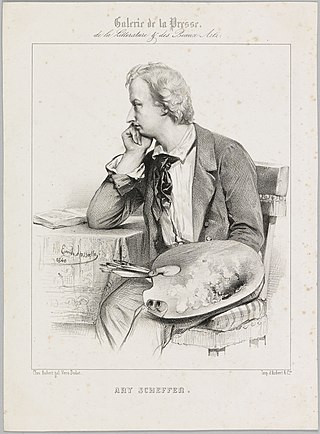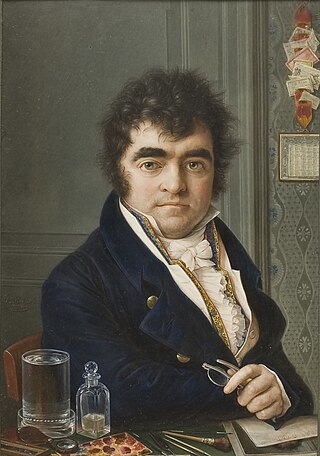

Louis Ducis (14 July 1775, Versailles - 2 March 1847, Paris) was a French painter and student of Jacques-Louis David.


Louis Ducis (14 July 1775, Versailles - 2 March 1847, Paris) was a French painter and student of Jacques-Louis David.
Louis Ducis was instructed by David, whom he partly imitated in his historical pieces, besides which he devoted himself also to genre and portrait painting. His 'Mary Stuart' and 'The Début of Talma' were formerly in the Luxembourg Gallery. He died in 1847.

Jacques-Louis David was a French painter in the Neoclassical style, considered to be the preeminent painter of the era. In the 1780s, his cerebral brand of history painting marked a change in taste away from Rococo frivolity toward classical austerity and severity and heightened feeling, harmonizing with the moral climate of the final years of the Ancien Régime.

Ary Scheffer was a Dutch-French Romantic painter. He was known mostly for his works based on literature, with paintings based on the works of Dante, Goethe, and Lord Byron, as well as religious subjects. He was also a prolific painter of portraits of famous and influential people in his lifetime. Politically, Scheffer had strong ties to King Louis Philippe I, having been employed as a teacher of the latter's children, which allowed him to live a life of luxury for many years until the French Revolution of 1848.

George Peter Alexander Healy was an American portrait painter. He was one of the most prolific and popular painters of his day, and his sitters included many of the eminent personages of his time. Born in Boston, he studied in Europe, and over his lifetime had studios in Paris and Chicago.

François Pascal Simon Gérard, titled as Baron Gérard in 1809, was a prominent French painter. He was born in Rome, where his father occupied a post in the house of the French ambassador, and his mother was Italian. After he was made a baron of the Empire in 1809 by Emperor Napoleon, he was known formally as Baron Gérard.
Events from the year 1785 in art.
Heinrich Karl Anton Mücke was a prominent Realist painter known for his liturgical and genre paintings as well as frescoes, which still adorn some of Germany's ancient castles and cathedrals. His paintings are hung today in Germany's leading museums, including the National Gallery Berlin, Breslau Museum and the Brunn Museum. His son, Karl Mücke, was also a recognized genre painter. Heinrich Mücke was a professor at the Düsseldorf Academy and received the Portuguese Medal for Art and Sciences as well as the Breslau Medal. He is associated with the Düsseldorf school of painting.

Louis Asher, originally Julius Ludwig Asher, (1804–1878) was a German artist.

Louis-Marie Autissier, was a French-born Belgian portrait miniature painter. According to Marjorie E. Wieseman, curator of European painting, at the Cincinnati Art Museum, "Autissier's success as a miniaturist was in large measure due to his talent as a colourist and his meticulous detailing of costumes and accessory." He is considered the founder of the Belgian school of miniature painting in the nineteenth century. Among his most accomplished pupils and followers were Alexandre Delatour (1780—1858), Louis Henry Fontenay (1800—1852), and Dominique Ducaju (1802—1867). His works are in the collections of the Cincinnati Art Museum, the Nationalmuseum and the Royal Collection.

Henri-Pierre Picou was a French painter. His oeuvre began with portraits and classical historical subject matter but he later moved on to allegorical and mythological themes.
Georg Bergmann (1821–1870) was a German painter of historical subjects and portraits.

Karl Friedrich Adolf Boser, was a German artist. He studied in Dresden, Berlin, and Düsseldorf; his paintings, chiefly genre subjects and portraits, were popular. He is associated with the Düsseldorf school of painting.

Thomas Brigstocke was a Welsh portrait painter. He studied art in London, and then spent eight years in Italy before returning to England. In the 1840s he visited Egypt, where he painted portraits of Mohammed Ali Pasha and his family.

John Byrne (1786–1847) was an English painter and engraver. He came from a family of artists and he lived with his sister Elizabeth Byrne who also exhibited her landscapes.

François Barthélemy Michel Édouard Cibot (1799–1877) was a French historical and landscape painter born in Paris. His masters were Guérin and Picot. During the first part of his career he devoted himself to historical painting, producing many sacred works, several specimens of which are to be seen in the churches of Paris. His most important work of this kind is the series of paintings representing Charity, in the church of St. Leu at Paris. About 1863 he applied himself to landscape painting. He died in Paris in 1877. Amongst his best works are:

Johann Stephan Decker was an Alsatian French painter.

Pierre-Alfred Dedreux, who signed his works as Alfred de Dreux was a French portrait and animal painter, best known for his scenes with horses.

Louis Dubois (1830–1880) was a Belgian painter who specialized in landscapes and Portraits in a naturalistic style. He also painted genre and still-life subjects.

Claude-Marie-Paul Dubufe (1790–1864) a French historical, genre and portrait painter, was born in Paris in 1790, and studied under Jacques-Louis David. His subjects were at first classical, and then scriptural. He then gave himself up to the painting of genre pictures and portraits. His reputation rests chiefly on his portraits, of which he produced a large number. Dubufe, who was the last representative of the school of David, died at Selle-Saint-Cloud in 1864.

Maria Elektrine Freifrau von Freyberg, born at Strasbourg in 1797, was the daughter and pupil of Johann Baptist Stuntz, a painter of landscapes, under whose tuition she gave proof of great ability. She visited France and Italy, and stayed at Rome some time. Her paintings of historical scenes are distinguished for a tender touch, and she was not less successful in portraiture and landscape painting. One of her best works is a Holy Family.The Birth of St. John, and two landscapes, in the album of King Louis of Bavaria, are by this artist; in the Leuchtenberg Gallery The Virgin and Child, and The Three Maries at the Tomb; and in the Munich Gallery a Holy Family, The Naming of St. John the Baptist, and A Boy playing the flute. She died at Munich in 1847.

Bernard Gaillot, a French historical painter, born at Versailles in 1780, was a pupil of Jacques-Louis David.